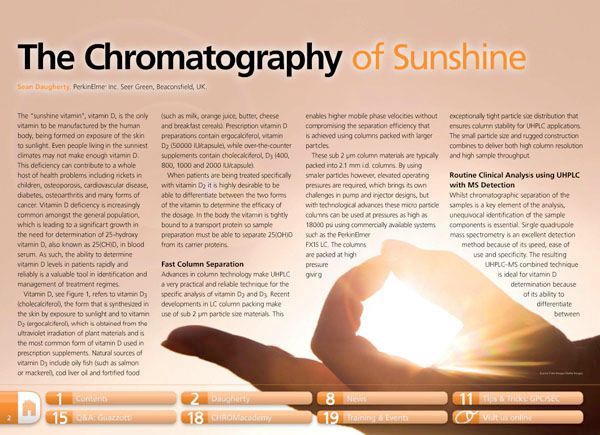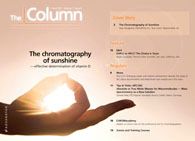The Chromatography of Sunshine
The ability to determine vitamin D levels in patients rapidly and reliably is a valuable tool in identification and management of treatment regimes.
The “sunshine vitamin”, vitamin D, is the only vitamin to be manufactured by the human body, being formed on exposure of the skin to sunlight. Even people living in the sunniest climates may not make enough vitamin D. This deficiency can contribute to a whole host of health problems including rickets in children, osteoporosis, cardiovascular disease, diabetes, osteoarthritis and many forms of cancer. Vitamin D deficiency is increasingly common amongst the general population, which is leading to a significant growth in the need for determination of 25-hydroxy vitamin D, also known as 25(OH)D, in blood serum. As such, the ability to determine vitamin D levels in patients rapidly and reliably is a valuable tool in identification and management of treatment regimes.
Vitamin D, see Figure 1, refers to vitamin D3 (cholecalciferol), the form that is synthesized in the skin by exposure to sunlight and to vitamin D2 (ergocalciferol), which is obtained from the ultraviolet irradiation of plant materials and is the most common form of vitamin D used in prescription supplements. Natural sources of vitamin D3 include oily fish (such as salmon or mackerel), cod liver oil and fortified food (such as milk, orange juice, butter, cheese and breakfast cereals). Prescription vitamin D preparations contain ergocalciferol, vitamin D2 (50 000 IU/capsule), while over-the-counter supplements contain cholecalciferol, D3 (400, 800, 1000 and 2000 IU/capsule).
When patients are being treated specifically with vitamin D2 it is highly desirable to be able to differentiate between the two forms of the vitamin to determine the efficacy of the dosage. In the body the vitamin is tightly bound to a transport protein so sample preparation must be able to separate 25(OH)D from its carrier proteins.
Reversed-Phases for LC Deliberately Doped with Positive Charge: Tips and Tricks for Effective Use
May 13th 2025In this month's edition of LC Troubleshooting, Dwight Stoll and his fellow researchers discuss both the benefits (improved peak shape/loading) and challenges (excessive interaction) associated with charge-doped reversed-phase (RP) columns for both analytical and preparative separations.
Investigating 3D-Printable Stationary Phases in Liquid Chromatography
May 7th 20253D printing technology has potential in chromatography, but a major challenge is developing materials with both high porosity and robust mechanical properties. Recently, scientists compared the separation performances of eight different 3D printable stationary phases.

.png&w=3840&q=75)

.png&w=3840&q=75)



.png&w=3840&q=75)



.png&w=3840&q=75)











